Preamble
Nigeria which is a country in the western region of a continent know for it's culture and tradition embedded with several values which includes and not limited to: moral, social, religious, political and aesthetic values all of which guides the choice of traditional attire of her people.
You could tell of a country with about 186 million citizens,
527 languages (seven of which are extinct), over 1150 dialects and ethnic groups, six political zones and three religions to have a vast number of attire that suits different traditions.
Nigerian traditional attire
According to the merriam-Webster dictionary, traditional means " an inherited, established, or customary pattern of thought, action, or behavior (as a religious practice or a social custom)" while an attire is a "dress, clothes; especially : splendid or decorative clothing"
Hence I could conclude that a traditional attire is "An inherited or customary decorative clothing"- Emmanuel Uguma.
Aim:
To appreciate the major Nigerian attire at the end of this series.
Episode 1: Agbada
If there is any Nigerian attire that has broken bounds among tribes, and culture it'll be agbada.
Agbada is one of the names for a flowing wide sleeved robe worn by men in much of West Africa, and to a lesser extent in North Africa
It is known by different ethnic groups outside Yoruba as:
- Boubou - Wolof (Senegal)
- babban riga - Hausa
- k'sa or gandora - Tuareg
- darra'a - Maghrebi Arabic
- agbada -Dagomba (Northern Ghana)
- grand boubou -Several Francophone West African countries
History
Historical account of it's genesis in West Africa
Its origin lies with the clothing worn by the Islamic Tukulor, Mandé and Songhai peoples of the 8th-century Takrur and Ghana Empires, and 13th-century Mali and Songhai Empires.
Arab merchants
The general consensus among scholars is that the attire originated in the middle east and was introduced to Africa by Berber and Arab merchants from the Mediterranean coast. Its use as clothing became widespread throughout the West African region with the migration of semi-nomadic groups such as the Fulani and traders such as the Dyula and Hausa.
Historical account of it's origin in Nigeria
In Nigeria, the origin of agbada has been a topic of contention in time past, was it originally designed by and for the Yorubas or was it influenced??
Before threading on histoical paths, It is worth of note that Agbada is a Yoruba term translated to English as clad, basin or washbasin.
Although the generic term across cultures tends to converge on agbada, in fact the form
of clothing has a Northern and Islamic provenance.
During the late eighteenth and the early part of the nineteenth century the balance of power in much of what is now known as Nigeria was disrupted by the impact of an Islamic jihad inspired by the legendary Muslim Fulani leader Usman dan Fodio.
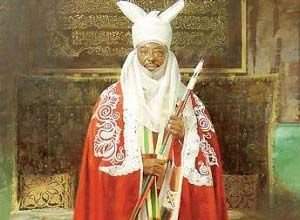 source
source
Dan Dodo,1784-1817
A fiery cleric-cum-warrior, Dan Fodio came
from what is now known as Senegal. Across the city states of the Hausa North down to the Nupe people on the banks of the Niger, and as far South as the Yoruba city of Ilorin, rulers were swept aside to be replaced by Muslim emirates. The main Yoruba power of Oyo was defeated, the capital city abandoned in the 1830s.
Owing their military power to supreme prowess on horseback, the new Fulani rulers brought with them a style of male dress consisting of flowing robes and huge baggy trousers adapted for horseback riding. They also brought an Islamic tradition of "robes of honour" where embroidered gowns and the flowing turbans worn with them became badges of office for both rulers
and court officials. Emirs and other rulers purchased the finest robes for themselves and distributed numerous others to their courtiers. An elaborate trade network developed with both Nupe and Yoruba weavers and embroiderers, along with specialist tailors,
cloth beaters, and dyers, serving the main emirates. Centres of excellence in embroidery grew up in Bida, Kano, Katsina, Dikwa, Daura and Ilorin (and continue to this
day). Royal courts beyond the ken of Fulani power such as the Yoruba kings adopted the same style of dress, and in the twentieth century the gowns became the de rigeur dress of important men across a large area of Nigeria and into neighbouring countries.
The oldest surviving riga is a Nupe gown in the 1841 Egga collection in the British
Museum.
ancient Nigerian chiefs
By the early nineteenth century, the attire has been adopted by many non-muslims in sub-saharan African countries like Nigeria most especially kings, chiefs, and elites, who not only modified it to reflect local dress aesthetics, but also replace the turban with indigenous head gears.
Agbada Pieces
Among the Yorubas, Agbada is a four-pieces attire worn strictly as a symbol of royalty and elites in ancient days.
These piece consist of:
- Awosoke (Upper vest): This is the large free flowing outta robe from which the entire robe derived it's name agbada meaning 'voluminous attire' but translated as basin, washbasin etc. as earlier mentioned.
 source
source
awosoke
This piece happens to be the largest of all pieces, a big, loose-fitting, ankle-length garment with three sections: a rectangular centerpiece, flanked by wide sleeves on both ends. The centerpiece covers front and back with elaborate embroidery from the neck region downwards whose density and extent of vary considerably, depending on how much the client can afford, it has a neck hole (orun) and big pocket (apo) on the left side.
- Awotele (Undervest):This is the vest worn just before the awosoke. There are two types of undervest: the buba- a loose, round-neck shirt with elbow-length sleeves; and dansiki- a loose, round-neck, sleeveless smock. There is also a version where the awotele comes in long sleeves, while the awosoke comes with much shorter sleeves than the normal Agbada,giving it an entirely different look (modern design).
.jpeg) source
source
modern Awotele
- Sokoto (Trousers): This is simply the pant worn with the Awotele just before the awosoke . For the Yoruba's, sokoto have a drawstring for securing them around the waist and come in a variety of shapes and lengths. The two most popular trousers for the agbada are sooro -a close-fitting, ankle-length, and narrow-bottomed piece (what we know as pencil or straight cut trousers) ; and kembe- a loose, wide-bottomed one that reaches slightly below the knee, but not necessarily as far as the ankle (what we know as baggy) .
 source
source
Sokoto kembe and a buba
- Fila (head gear/cap): This is the last piece worn to compliment the agbada and could also be left out. There are different types of fila with the most popular being
gobi- cylindrical in form, measuring between nine and ten inches long. When worn, it may be compressed and shaped forward, sideways, or backward.
 source
source
gobi
abetiaja- literally meaning "the dog-eared" the abetiaja has a crestlike shape and derives its name from its hanging flaps that may be used to cover the ears in cold weather. Otherwise, the two flaps are turned upward in normal wear.
 source
source
abetiaja
labankada is a bigger version of the abetiaja.
Wearing Agbada
Agbada can be worn in different ways and style to fit individual taste, societal status and even gender (in recent time).
Among Kings, chiefs and elites
The agbada worn among these people is more sophisticated that those trending among the mass
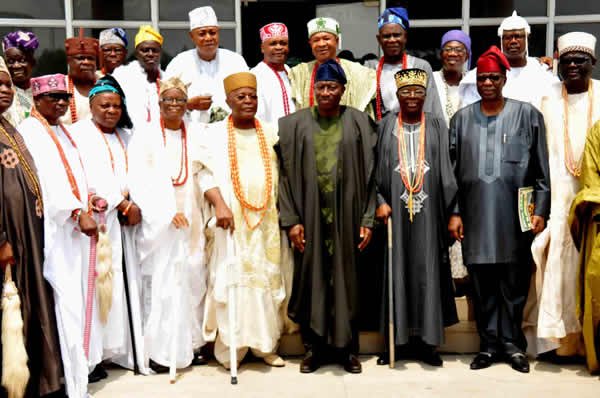 source
source
a cross section of Yoruba Kings, chiefs and Nigeria's former president
It is common practice or tradition for a king to dress with all atom of royalty, from their Awosoke to their awotele to their sokoto to their fila. What differentiates a king from his chiefs and other elites are the nature of their embroidery (as most times a kings embroidery is embedded with royal beads and some very rare wool), their Fila, beads worn on their neck and wrist, and also their staffs.
.jpeg) source
source
oba Aremu Gbadebo and chief
ooni of Ife and Alake of egba land
Today, agbada is worn by almost everybody irrespective of the tribe, color or gender either as long, short voluminous or less voluminous size
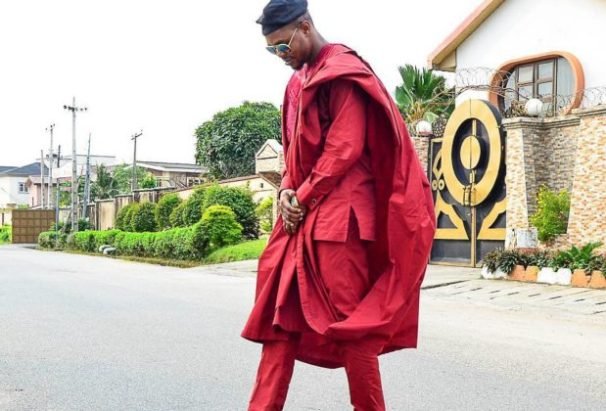 source
source
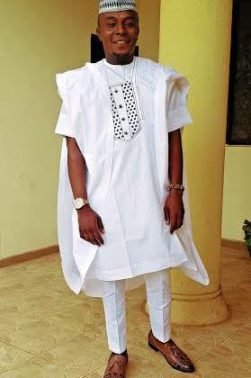 source
source
Agbada is of two major types of agbada
- agbada iwole (casual agbada): This is smaller, less voluminous, and often made of light, plain cotton, also called sapara, named after a Yoruba medical practitioner (Dr. Oguntola Sapara) in the 1920s.
.jpeg) source
source
agbada iwole
- agbada amurode (ceremonial agbada): also called Sulia is bigger, more ornate, and frequently fashioned from expensive and heavier materials. The largest and most elaborately embroidered is called agbada nla (big agbada) or girike
.jpeg) source
source
agbada amurode
So in the process of thinking which agbada to wear it is also important to consider which occasion it will be used for.
Today ladies and children are not left outof the trend as families now style in agbada together.
 source
source
a cross section of ladies in agbada
a family in their agbada style
Accessories that goes with agbada
A good Agbada is a waste of large yards of material without the right accessories; it’s like eating Nsala Soup without pounded yam.-Noble Igwe
Wearing the right accessories with your agbada is as important as wearing the agbada itself having in mind that it is already very bulky so wearing too much accessories will only make you look like "a people" (lol).
Here is my recommendation for you.
MEN:
- a flat, simple but sweet wrist watch
- a shoe (without lace) to complement the dominating color on the material, embroidery or cap.
- red or white beads for the neck and wrist (for traditional look only).
- a sweet fragrance applied (not in excess)
- a gold necklace, worn inside to give you a feeling of sophistication
.jpeg) source
source
WOMEN:
- earrings (depends on your hair do): A small but sophisticated stud earring size is best because of the bulky nature of agbada, but then for natural weaves or low-cut a moderate sized hoops or huggies will do.
- wristwatch: a Less BulKy designed wristwatch will do.
- shoes: a stiletto, cut out, sling back, ankle strap or corset heel will be just fine
- finger ring (if you choose to though)
And don't forget to keep the makeup simple and sweet
To round this up I'll love to share with you a poem by James Amuta.
Agbada and Our Virgins
Do we still have any virgins left
Who was not born still, blind and bone-deaf?
Whose virtue can exercise thrift
When Naira is flaunted by the agbada-clad thief?
Can that virgin resist the thief in agbada
Who rides in long trains of tints and sirens,
Whose tongue is spiced with the breath mints of Naira,
And ready to blaze treasures like fire fountains?
When our virgins were raped by Khaki
We shed our blood to put Agbada in his place
Now our virgins are defiled with our own money
By Agbada who hid his khaki under a solemn face.
Now, should we watch the virgins of our people
Defiled by Agbada (who extorted our trust)
Not for the good of the people - but for evil-
A selfish ritual to retain khaki-power at all cost?
James Amuta
Reference:
1,
2,
3,
4,
5,
6,
Agbada: an essay on the power of cloth.pdf

Passion For FashioN
Interviewer:Why are you here on steemit
Me: To add More values to the fashion tag

.jpg)

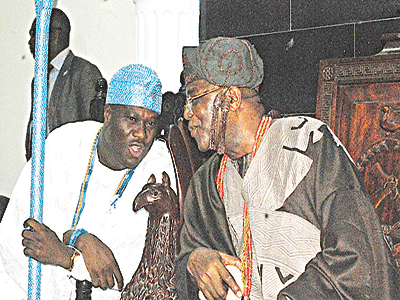
.jpeg)
.jpeg)
@gaman you're on the @abusereports naughty list!
If you do not stop, your account will be rendered invisible on Steemit. Bad Steemian! Bad!